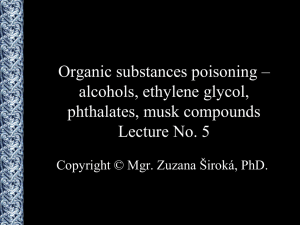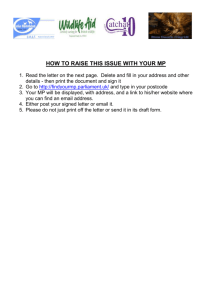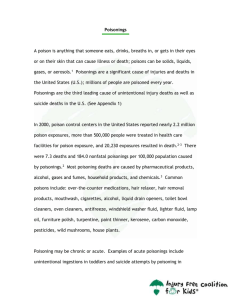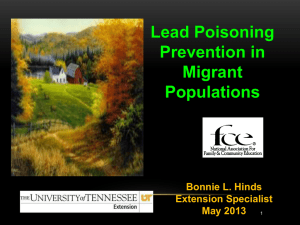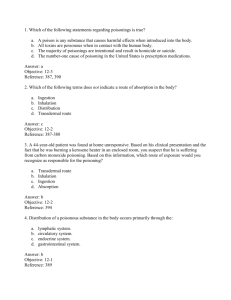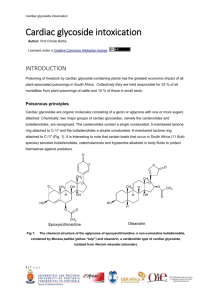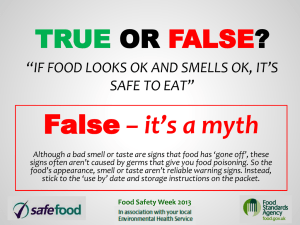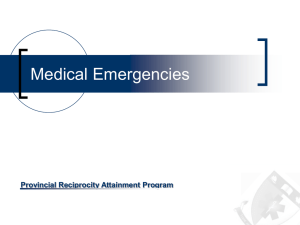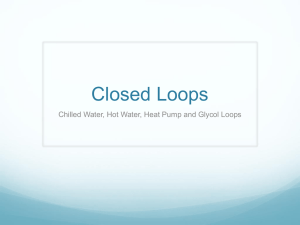Assessment and management of the adult poisoning
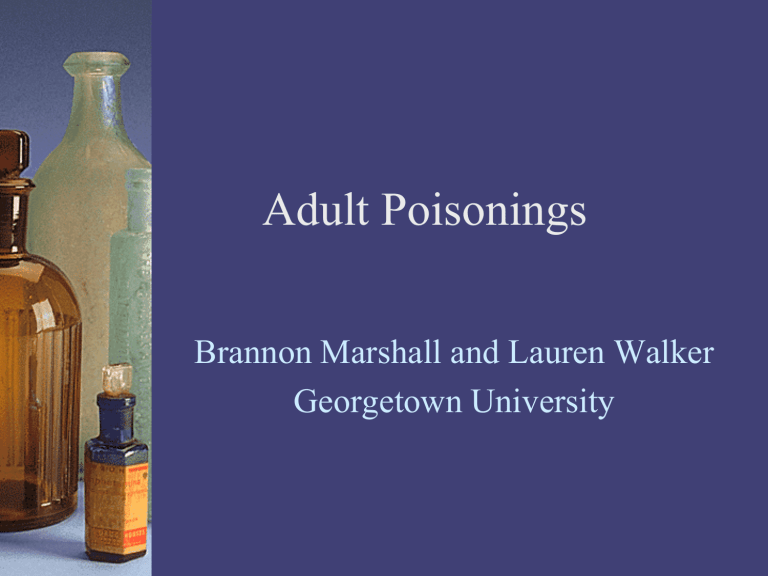
Adult Poisonings
Brannon Marshall and Lauren Walker
Georgetown University
Objectives
Discover the prevalence of poisonings in the
United States
Understand the primary assessment of the patient with a poisoning including the diagnostic workup
Learn about the clinical manifestations of the top two substances of intoxication
Review the appropriate pharmacologic and therapeutic management of poisoning and
Review the above findings with a case study
Prevalence of Poisonings
• 2-5 million poisonings and drug overdoses annually in the US
• 60 poison control centers: 2,384,825 exposures
•
Females > Males
•
Ages: 20-29 most prevalent: exposures decline with age
• 965 active generic codes: 541- nonpharmaceutical, 424 pharmaceutical
61 national poison centers take over 4 million calls
Hospital Prevalence
•
Poison exposures account for 5-10% of all
ER visits
•
Greater than 5% of all adult ICU admissions
•
Annual incidence of poisoning is increasing with a 4.6% increase in cases noted in 2000-
2001
•
Routes of poisoning: Ingestion 83.5%, dermal, inhalation/nasal, ocular.
Burns, M. (2006). General approach to drug poisoning in adults.
Retrieved June 28, 2012, from https://vcuhsra.mcvhvcu.edu/f5-w-687474703a2f2f7777772e7570746f646174652e636f6d$$/contents/general-approach-to-drug-poisoning-inadults?source=search_result&search=poisoning&selectedTitle=1%7E150
Other Statistics
•
95 percent of episodes caused minor or no effects
• 92 percent were due to acute rather than chronic ingestions
• 92 percent involved a single substance
• 85 percent were unintentional
• 59 percent of poison fatalities occurred in individuals aged
20 to 49
• 52 percent of exposures occurred in children younger than
6 years
• 47 percent involved pharmaceuticals
Burns, M. (2006). General approach to drug poisoning in adults.
Retrieved June 28, 2012, from https://vcuhsra.mcvhvcu.edu/f5-w-687474703a2f2f7777772e7570746f646174652e636f6d$$/contents/general-approach-to-drug-poisoning-inadults?source=search_result&search=poisoning&selectedTitle=1%7E150
Top 25 Substances Most Frequently involved with poisonings
•
Analgesics
• Vitamins
• Cosmetics/personal care
• Bites and environmental
•
Cleaning susbstances • Antimicrobials
(household) •
Hormones and hormone antagonists
•
Sedative/hypnotics/antipsychot • Plants ics • Gastrointestinal preparations
•
Foreign bodies/toys/misc • Stimulant and street drugs
•
Topical preparations • Anticonvulsants
•
Antidepressants
•
Hydrocarbons
•
Cardiovascular drugs
• Chemicals
•
Antihistamines
• Arts/crafts/office supplies
• Fumes/gases/vapors
•
Pesticides
• Electrolytes and minerals
• Alcohol
• Cold and cough preparations
Substances most frequently involved in adults
•
Analgesics
•
Sedative/hypnotics/antipsychotics
•
Antidepressants
•
Cleaning substances (household)
•
CV drugs
•
Alcohol
Patient Assessment
Diagnostic Work-up
Antifreeze Poisoning
Methanol and Ethylene Glycol
Inflict self-harm, by accident, illicit distillation ("moonshine") or occult substitution for ethanol
• Rapidly and completely absorbed after oral ingestion
• Peak serum alcohol concentrations reached within 1-2hrs.
• Ingestion of approximately 1 g/kg of either methanol or ethylene glycol is considered lethal
• serious toxicity has been reported following ingestions of as little as
8 g of methanol.
Methanol and ethylene glycol are relatively nontoxic, and cause mainly central nervous system (CNS) sedation.
However, profound toxicity can ensue when these parent alcohols are oxidized
S/S of Antifreeze Poisoning
•
May present with mild CNS effects
(inebriation and sedation) similar to ethanol intoxication
•
Methanol metabolite formulate and the ethylene glycol metabolites accumulate causing:
–
End-organ Damage, Visual Blurring
–
Central Scotomata and Blindness
Ethylene glycol metabolism
•
Metabolites target the kidney and l/t reversible acute renal failure
– primarily due to glycolate-induced damage to tubules, although tubule obstruction from crystals
•
Oliguria and hematuria
•
Hypocalcemia from calcium oxalate formation
– cranial nerve palsies and tetany
Methanol Metabolite
•
Retinal injury with optic disc hyperemia
•
Retinal edema
•
Permanent blindness
•
Ischemic or hemorrhagic injury to the basal ganglia
•
Coma, seizures, kussmaul respirations and hypotension all suggest a substantial portion of the parent alcohol has been metabolized to its toxic byproducts.
•
Acidemia increases the ability of the toxic metabolites to penetrate cells
– further depressing CNS function and causing a rapid downward spiral of hypoxia and acidemia
Clinical Manifestation
Acetaminophen
Available in both IR and SR formulations
Therapeutic dose: 325 to 1000 mg/dose Q4-6 hrs with a max daily dose 4 g in adults (new rec. say 1-2 grams)
• Therapeutic serum concentrations range from 10- 20 mcg/mL
–
Unlikely to result from a single dose of less than 7.5 to 10 g for an adult
–
Likely to occur with single ingestions greater than 250 mg/kg or those greater than
12 g over a 24-hour period
• Absorbed from the GI tract
•
Metabolized by liver
•
Peak serum conc. are reached within 4 hrs after OD
• Elimination ½ life range from 2-4 hrs
Acetaminophen
•
Therapeutic doses: 90% is metabolized to sulfate and glucuronide conjugates
excreted in the urine
•
Remainder is metabolized via the hepatic CYP450 into
NAPQI
– Appropriate dose produces a small amount of NAPQI: rapidly conjugated and excreted in the urine.
•
NAPQI reacts with hepatocytes, and injury ensues = oxidative injury and hepatocellular centrilobular necrosis
–
Cytokine release may l/t a secondary inflammatory response from Kupffer cells = more hepatic injury
Acetaminophen Clinical
Manifestations
•
Stage I (0.5 to 24 hours) N/V, diaphoresis, pallor, lethargy, and malaise. Some remain asymptomatic. Laboratory studies are typically normal.
–
Initially symptoms may resolve and appear to improve clinically while subclinical elevations of hepatic
AST, ALT occur
• Stage II (24 to 72 hours) clinical and laboratory evidence of hepatotoxicity and some nephrotoxicity RUQ pain, with liver enlargement and tenderness.
The initial manifestations are often mild and nonspecific and don’t reliably predict hepatotoxicity
Tylenol Manifestations Cont.
•
Stage III (72 to 96 hours) — LFT abnormalities peak from
72 -96 hours after ingestion. The systemic symptoms of stage I reappear with jaundice and encephalopathy
•
Stage IV (4 days to 2 wks) — Patients who survive stage
III enter a recovery phase that usually begins by day 4 and is complete by 7 days after OD
– Renal function spontaneously returns to the previous baseline within 1to 4 wks, although dialysis may be required during the acute episode
Management
Case Study
•
Scenario: 49 y/o male ingested a gallon of antifreeze in a suicide attempt. EMS transported him to the ED
•
Laboratory Data: In the ED: methanol 0,
ABG pH 7.05/pCO2 26/pO2 313, BE 24
•
Na 150, K 4.7, Cl 110, HCO2 5, BUN 13
CR 1.4 GLU 100
Hours after arrival
0.5
12
18
Ethylene glycol (mg/dL) Osmolar Gap
1282
770
554
235
157
122
Laboratory Data in the ED:
Methanol 0,
ABG pH 7.05/pCO2 26/pO2 313, BE 24
Na 150, K 4.7, Cl 110, HCO2 5, BUN 13 CR 1.4
GLU 100
Clinical Course
•
• He was intubated and sedated, gastric lavaged returned 1200 ml of fluid with the appearance of antifreeze. Fomepizole and CVVHD were initiated. Bicarb bolus was given in ER. HR
73, BP 133/71, NSR. He was able to follow commands.
• Day 2 he became unresponsive. Head CT showed bilateral subarachnoid hemorrhaging.
Family decided to institute comfort measures and he expired on Day 4
•
Autopsy Findings: Many polarizable crystals were present in the kidneys consistent with calcium oxalate. Cause of death: ethylene glycol intoxication
Bronstein, A., Spyker, D., Cantilena, L., Green, J., Rumack, B., & Dart, R. (2011). 2010 annual report of teh american association of posion control centers' national posion data system (NPDS): 28th annual report. ().Informa Healthcare USA, Inc. doi:10.3109/15563650.2011.635149
Patient Pearls
•
Poison control centers are free, confidential and open 24 hours a day, seven days a week and 365 days a year.
•
Some medicines are dangerous when mixed with alcohol
•
Keep potential poisons in their original containers. - DO NOT use food containers such as bottles to store household and chemical products
References
•
American association of poison control centers: Poison prevention tips for adults.
(2012). Retrieved June 26, 2012, from http://www.aapcc.org/dnn/poisoningprevention/adults.aspx
•
Bronstein, A., Spyker, D., Cantilena, L., Green, J., Rumack, B., & Dart, R. (2011). 2010 annual report of teh american association of posion control centers' national posion data system (NPDS): 28th annual report. ().Informa
Healthcare USA, Inc. doi:10.3109/15563650.2011.635149
• Burns, M. (2006). General approach to drug poisoning in adults.
Retrieved June 28, 2012, from https://vcuhsra.mcvh-vcu.edu/f5-w-687474703a2f2f7777772e7570746f646174652e636f6d$$/contents/generalapproach-to-drug-poisoning-in-adults?source=search_result&search=poisoning&selectedTitle=1%7E150
• Burns, M., Friedman, S. & Larson, A. (2011). Acetaminophen (paracetamol) poisoning in adults: Pathophysiology, presentation and diagnosis.
Retrieved June 28, 2012, from https://vcuhsra.mcvh-vcu.edu/f5-w-
687474703a2f2f7777772e7570746f646174652e636f6d$$/contents/acetaminophen-paracetamol-poisoning-in-adultspathophysiology-presentation-anddiagnosis?source=search_result&search=acetaminophen+poisoning&selectedTitle=3%7E48
•
Pierzak, M., Kuffner, E., Morgan, D., & Tomasgewski, C. (1999). Clinical policy for the initial approach to patients presenting with acute toxic ingestion or dermal or inhalation exposure.
Analysis of Emergency Medicine, 33 (6), 735-
761.
•
Sivilotti, M., & Wichhester, J. (2012). Methanol and ethylene glycol poisoning.
Retrieved June 2, 2012, from https://vcuhsra.mcvh-vcu.edu/f5687474703a2f2f7777772e7570746f646174652e636f6d$$/contents/methanol-andethylene-glycol-poisoning?source=search_result&search=antifreeze+posioning&selectedTitle=1%7E55#H2
•
Watson, I. (2002). Laboratory analyses for poisoned patients: Joint position paper.
The Association of Clinical
Biochemists, 39 , 328-339.
